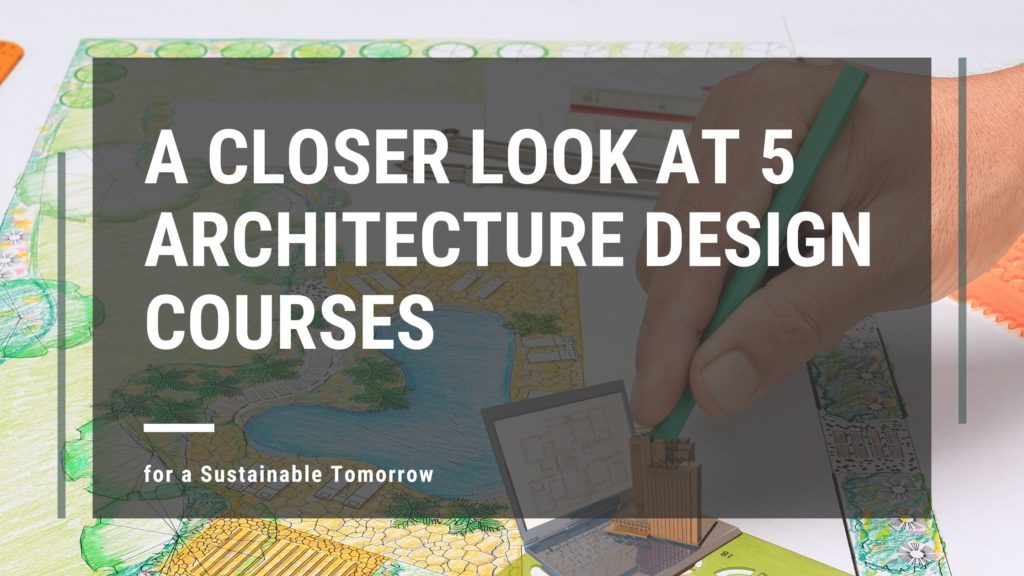A Closer Look at 5 Architecture Design Courses for a Sustainable Tomorrow
 Architecture is more than planning, designing, and constructing buildings. To be a successful architect, you will require more than basic knowledge about materials, technology, engineering, and aesthetics. Today, there is a huge demand for sustainability. From the tiniest of houses to the tallest skyscrapers, you will need to incorporate sustainability and design with a purpose in mind.
Architecture is more than planning, designing, and constructing buildings. To be a successful architect, you will require more than basic knowledge about materials, technology, engineering, and aesthetics. Today, there is a huge demand for sustainability. From the tiniest of houses to the tallest skyscrapers, you will need to incorporate sustainability and design with a purpose in mind.
In the field of architecture, sustainability is taking center stage, so it is time to take courses related to it. It is now the responsibility of architects to make their designs eco-friendly, whether they are designing new buildings or revamping existing ones.
Discover sustainable design’s secrets with these five essential architecture design courses. From digital blueprints to visionary landscapes, these courses are the compass guiding architects toward an innovative, eco-conscious future.
Revit: Mastering Blueprints
Revit isn’t just software; it’s an architect’s creative hub.
Once you master this software, you will be able to create detailed drawings or renderings. It’s where ideas come to life before the first brick is laid, allowing architects to refine sustainable designs with precision. Due to the advanced nature of Revit, you will need to take a Revit course to learn how to use it.
In a Revit course, you’ll delve into crafting intricate blueprints—floor plans, elevations, and material specifications—all within this digital realm. Mastery of this tool becomes invaluable in enhancing the efficiency of sustainable design processes.
Furthermore, within the Revit course, you’ll learn to create predefined parameters. This mastery enables the creation of detailed renderings and design models, ensuring precision in drawings and constructing better buildings
Building Information Modeling (BIM): Crafting Visions
Opting to learn about BIM, or building information modeling, is the best decision that you can make for your career. You can learn how to plan, design, and construct buildings and structures with ease.
By learning BIM, you will no longer require drawings or blueprints. You can effortlessly create 3D models and realistically view the blueprints of your building plan.
BIM acts as the director, guiding sustainable designs in a three-dimensional space. This learning opportunity offers insights into modeling, capturing materials, allocating space, and detailing elevations for sustainable designs.
AutoCAD Civil: Precision Planning
In the AutoCAD course for civil engineers, you can learn how to plan and design the construction of infrastructure. This includes houses, dams, roads, bridges, sewage systems, and tunnels. The course extensively covers everything from modeling to visualization, rendering, and dimensioning. By the end of the course, you will have a clear understanding of how to use AutoCAD for your civil projects.
Imagine you’re involved in designing a new area, like a neighborhood or community. AutoCAD Civil is a software tool that assists in planning where things should be located. These things can be houses, roads, parks, and more.
It helps ensure there’s ample space for green areas and essential infrastructure, making the area not just functional but also environmentally friendly. Essentially, AutoCAD Civil aids in creating well-organized and eco-conscious spaces for people to live and thrive in.
3Ds Max: Visualizing Tomorrow
3D Max is the storyteller, emphasizing rendering and animation to breathe life into architectural designs. It’s the medium for painting photorealistic visions of a sustainable future.
It focuses on using rendering (creating realistic images) and animation to make architectural designs look alive and real. It’s like adding movement and detailed visuals to bring those designs to life on screen.
In the 3ds max course, you will learn how to create photorealistic designs and develop renderings for all your projects.
Civil 3D: Managing Sustainable Projects
Managing eco-friendly projects requires finesse.
By learning civil 3D, you will be able to seamlessly plan, design, and deliver water, transportation or land projects. With Civil 3D, you can quickly design and document your work and tasks without any glitches.
Civil 3D’s advantage lies in its ability to model and analyze infrastructure designs more efficiently. This helps engineers consider sustainable options by quickly testing different scenarios to minimize environmental impact, optimize resource usage, and ensure the long-term sustainability of projects.
Apart from taking into consideration the function, structure, aesthetics, cost-effectiveness, and overall structure, these architecture design courses for civil engineers will help all to consider the sustainability factor of their projects.
In this architect’s toolkit, Revit and BIM lead the way in blueprint precision, while AutoCAD Civil, 3Ds Max, and Civil 3D each offer unique contributions to crafting sustainable environments. With these tools, architects don’t just design; they sculpt sustainable legacies, blending innovation with environmental consciousness.
Right from the materials to the methods that are used for energy consumption and the impact on the environment, you have to consider all of these factors while designing a sustainable building.
If you are looking for architecture design courses that can propel your career and boost your success, sign up for a course at the CADD Centre. Taking the time to master civil 3D courses like 3Ds Max, Revit, BIM, AutoCAD, and Civil 3D can give you an edge over your peers and propel you to the forefront. Mastering these tools can help you plan, design, and render all your sustainable projects in a better manner.
Our civil engineering training courses and architecture courses have the right combination of classroom and hands-on training to equip you with the latest skills and knowledge needed to help you evaluate, analyze, and oversee the construction of buildings, roads, water systems, and bridges.
Not only will you be learning intensively about new techniques and the latest in technology, but you will also be learning about sustainability. Understanding more about sustainability can help you build eco-friendly structures.
Whether you’re an established builder or an aspiring architect, enrolling in an architectural design course from CADD Center can equip you with the knowledge to foster sustainability in your building projects. From using green building materials to reducing waste, conserving resources, and building structures that are energy-efficient, taking online architecture courses from the CADD Center can help you master sustainable architectural practices and position yourself for success.
FAQ
Q: Why should I enroll in an architectural design course?
Enrolling in an architectural design course is crucial for aspiring architects as it provides a comprehensive education in the principles, techniques, and creative processes essential for successful architectural practice.
Q: What Career Opportunities Can I Pursue After Completing an Architectural Design Course?
Completing an architectural design course opens up a multitude of career opportunities in the dynamic field of architecture.
- Architectural Firms: Graduates can work in architectural firms, contributing to the design and planning of various projects.
- Urban Planning Agencies: Those with a specialization in urban design may find opportunities in municipal planning and development.
- Interior Design Studios: Specializing in interior design opens doors to careers in creating appealing and functional interior spaces.
Q: How do eco-friendly materials contribute to building a sustainable future?
Eco-friendly materials contribute to a sustainable future by minimizing impact, conserving resources, and fostering a greener, more resilient environment. Embracing these materials aligns with long-term environmental goals, promoting responsible practices for a healthier planet.
Q: What Makes SketchUp a Preferred Tool for Architectural Presentations?
SketchUp stands out as a preferred tool for architectural presentations due to its seamless blend of visual appeal, detailed modeling, and flexibility for design changes.



